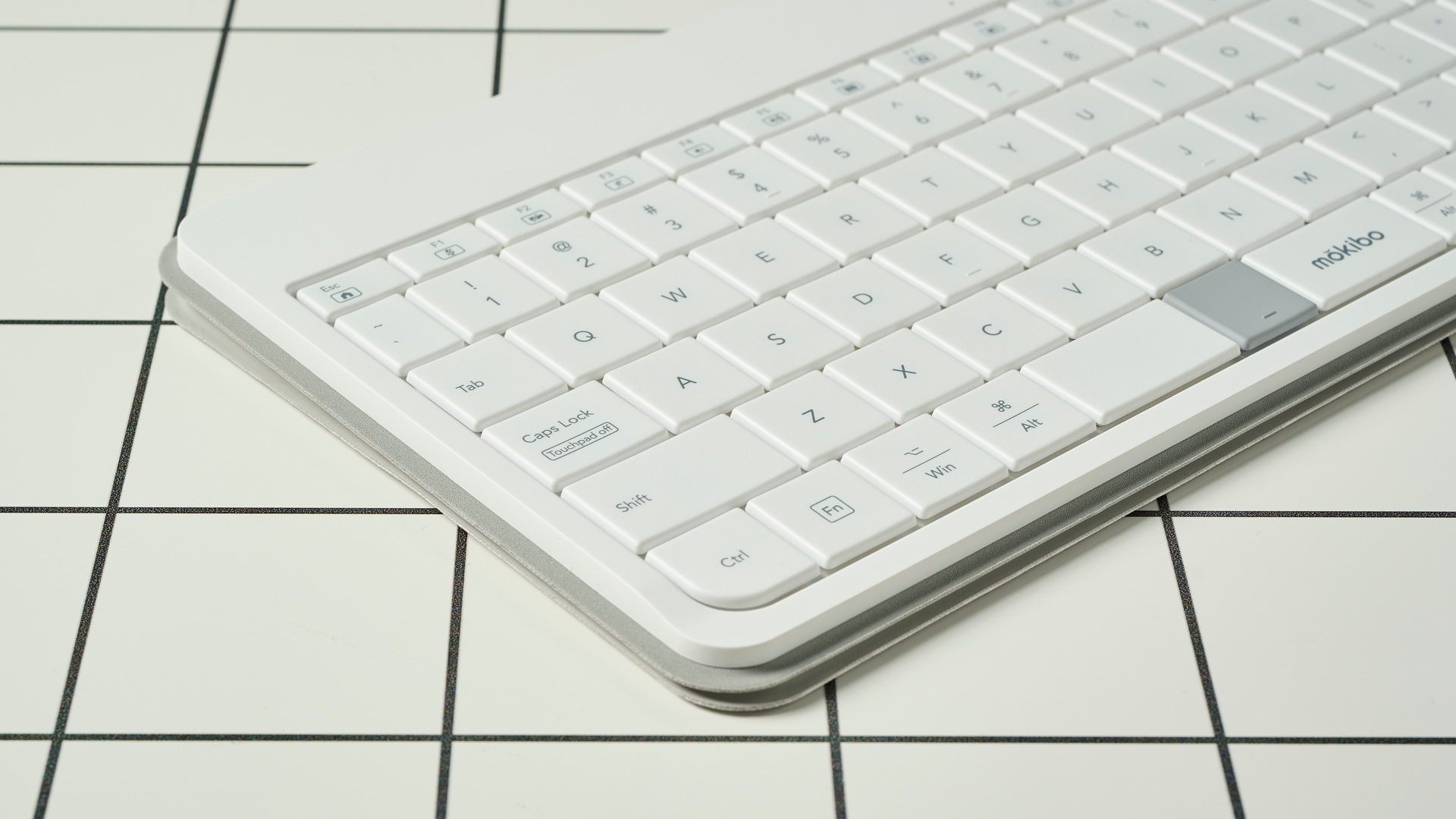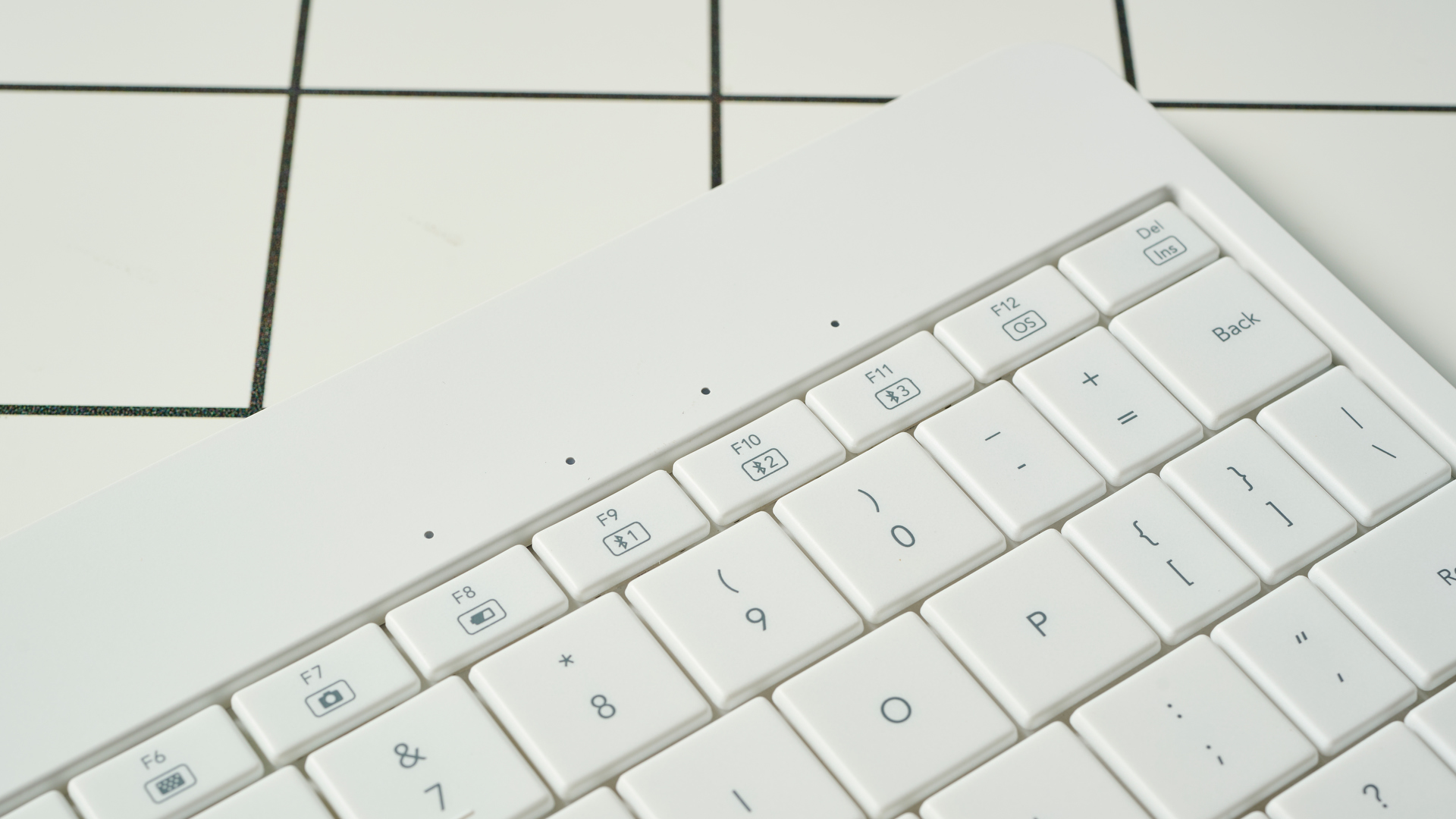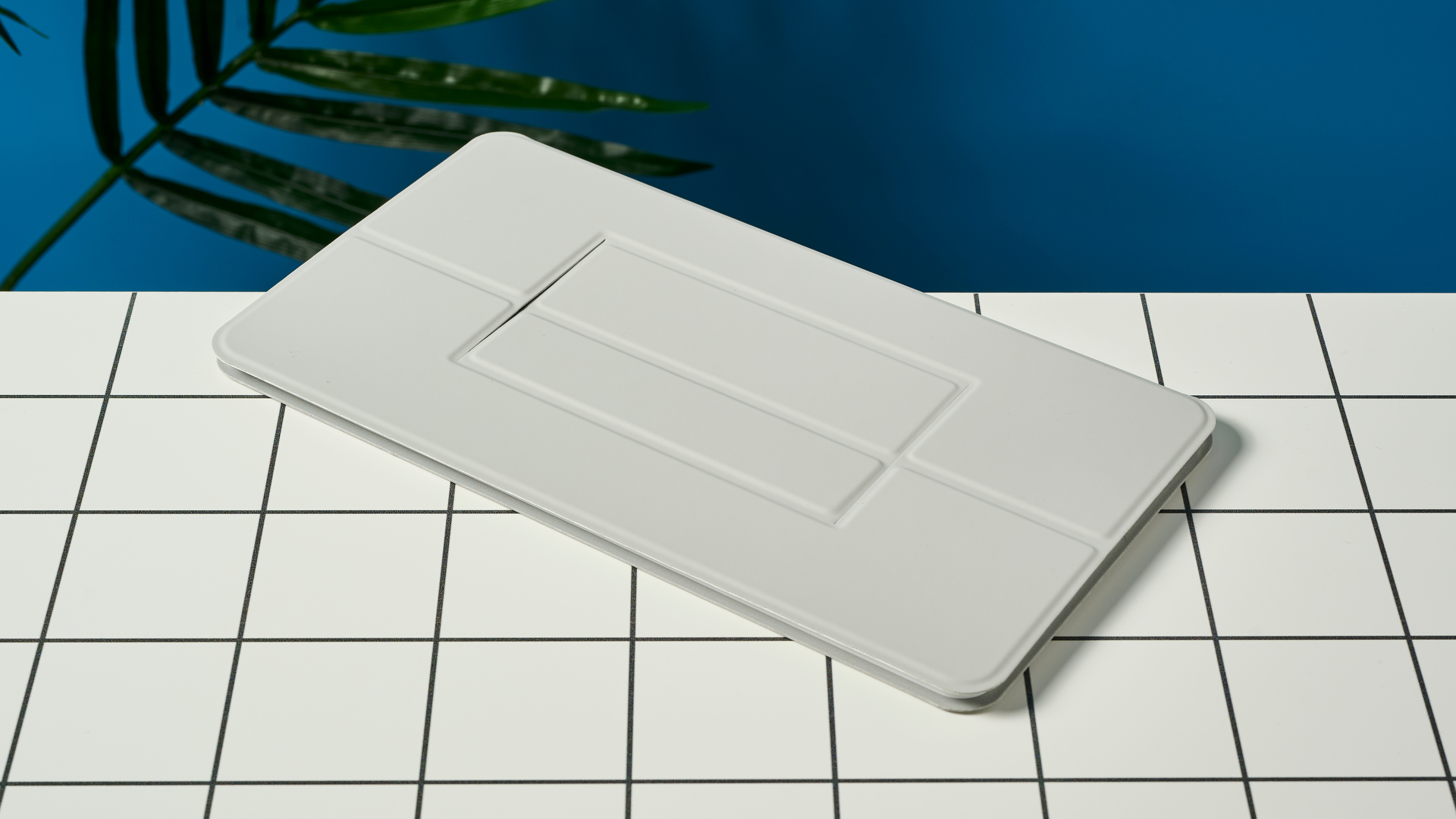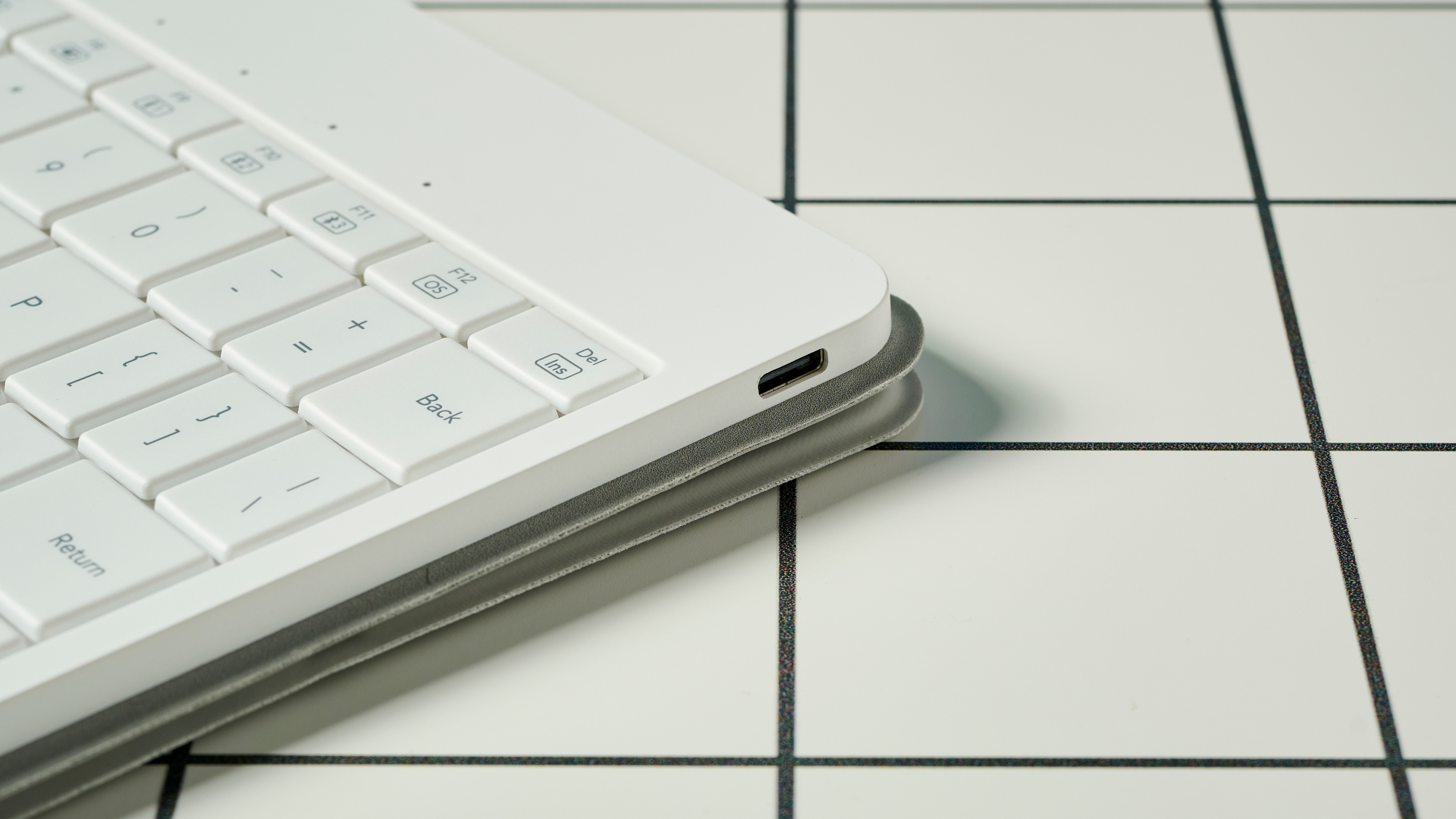Tom's Guide Verdict
Compact and lightweight, Mokibo’s Fusion Universal tablet keyboard is a keyboard and touchpad all in one. Here’s the bad news: it’s got a steep learning curve and the touchpad often wastes more time than it saves. But this unique keyboard could be perfect for a select few.
Pros
- +
Supports portrait or landscape orientations
- +
Lightweight
- +
3 Bluetooth channels
Cons
- -
No charger included
- -
Steep typing learning curve
- -
Touchpad sometimes laggy
- -
No backlight
Why you can trust Tom's Guide
We’ve all been there. I’ve been there. When you buy the newest iPad (or, like me, you buy a 4-year-old one for $200), you don’t want to fork out another $300 for the Apple iPad Magic Keyboard. But you also want a keyboard that utilizes all of the features you bought an iPad for, like multi-touch gestures, so how do you find one of the best iPad keyboards?
Enter the Mokibo Fusion Universal tablet keyboard, the most unique iPad keyboard I’ve ever seen. Rather than having a keyboard with a separate touchpad, the touchpad is the keyboard. Fusion Universal instantly transforms from keyboard to touchpad depending on the gesture: if you type, it’ll be a keyboard. If you tap or swipe across the keys, it’ll be a touchpad. So excuse my overwhelming intrigue when I found this nifty little tablet keyboard. I had to test it out.
Compatible with iPadOS, iOS, macOS, Windows, Linux, and Android devices, the Fusion Universal is one of the lightest tablet keyboards I’ve come across, about a quarter of the Apple iPad Magic Keyboard, and half the weight of Logitech’s Rugged Folio. It’s also $209 cheaper than Apple’s native iPad keyboard and $60 cheaper than the Zagg Pro Keys Wireless Keyboard with Trackpad ($199).
I tested the keyboard predominantly with an iPad 9 for this Mokibo Fusion Universal tablet keyboard review. Should you buy this unique peripheral? Read on to find out.
Mokibo Fusion Universal Tablet Keyboard review: Cheat sheet
- Who is it for? Those who don’t want to spend $300 on Apple’s iPad keyboard but still want to use multi-touch gestures
- What does it cost? The Mokibo Fusion costs $128 on Amazon
- What does it do well? It’s lightweight and versatile
- What are its weaknesses? The touchpad is sometimes laggy and not intuitive
- What should you use it for? Casual typing and creative tasks
Mokibo Fusion Universal Tablet Keyboard review: Specs
| Header Cell - Column 0 | Mokibo Fusion Universal Tablet Keyboard |
|---|---|
| Price | $130 |
| Dimensions | 10 x 11.2 x 0.2 inches |
| Weight | 11 ounces / 345g |
| Windows/Android/iOS/Linux | Yes |
| Battery life | 60 hours on one charge (rated) |
| Batteries | USB-C rechargeable (charging cable not included) |
| Connectivity | Bluetooth 5.1 |
Mokibo Fusion Universal review: The ups
Being super lightweight and portable, the Mokibo Fusion Universal seems great for traveling and supporting your workflow when you're out and about. It also has no magnetic case attachment, so you can align your tablet however you want.
Choose your alignment

Unlike the Apple iPad Magic Keyboard, which forces you to use your iPad in landscape due to its magnetic connectors, the Mokibo has no magnetic attachment, so you can choose whatever orientation suits your current needs. I write novels in my free time and I find that portrait is the perfect orientation for my writing app Scrivener. Similarly, on apps like Goodnotes, you can use portrait, which mimics printed pages most accurately. So, in comparison with Apple’s keyboard, this is a major win.
Because no magnets secure your device into place, you can prop up both your iPad and phone on the keyboard if so required. I used the multi-device connection capability to connect to my iPhone and iPad simultaneously. That feature is useful if you're on a video call on your phone and need to make notes on your iPad and flick between screens for relevant apps.
Get instant access to breaking news, the hottest reviews, great deals and helpful tips.
Lightweight

At only 11 ounces, this is a super lightweight option, far lighter than Apple’s iPad keyboard at 1.6 pounds.
It’s markedly lighter than the Logitech Slim Folio ($119), which is 1.1 pounds and has a backlight but no touchpad. It's also lighter than Logitech's Rugged Folio ($139), which is 1.3 pounds. Overall, the Mokibo Fusion is a really lightweight keyboard and will slip into your bag unnoticed.
Left handed? Not left behind
As a part of the 11% of humans who prefer their left hand to their right, I’m often locked out of “intuitive” touchpad designs. It’s bad enough that I have to buy different can openers, let alone that I’m unable to use most ergonomic mice on the market. But that’s a qualm for another day.
Thankfully, Mokibo has not forgotten about us lefties with the Fusion Universal touchpad. You can change the configuration of the touchpad to suit your needs, and it’s really simple. The keyboard ships in right-handed mode (obviously) but fellow lefties can simply hold down ‘fn’ and press L, E, F, T in that order to active left-handed mode. The two LED dots on either the left or right side will flash white, telling you which configuration you’re using.

And it really is a requirement. For the purpose of testing, I set my keyboard to the right-handed configuration, and I couldn’t use it. The gestures wouldn’t respond and I couldn’t scroll down web pages unless I used my right hand. One might think it obvious, but I had to, for science. I promptly switched back to left-handed mode and didn’t look back.
Multi-device connection

You can connect to three devices on different Bluetooth channels, and Mokibo supports everything from iOS to Linux. I also connected to a Samsung Galaxy Z Flip 4 and a Microsoft Surface Book 3 running Windows 10, which connected instantly and worked with no problems.
Changing OS channels is easy with Mokibo’s auto-recognition (and if it doesn’t auto recognize it’s fn+f12 to flip through OS channels), and keystrokes are just as responsive as on my iPad. The Fusion Universal is also designed to remember your device’s settings, so you shouldn’t have to do that again.
Mokibo Fusion Universal review: The downs
Despite the Fusion Universal’s orientation versatility and built-in touchpad, there are some downsides to the lightweight portable keyboard.
No magnets, a double-edged sword

While the lack of a magnet means you can choose your orientation, it also means if you’re typing on an unstable surface, your tablet might leap from your lap like a dancing salmon.
I was typing on my iPad on a bus and, while it was still usable, I was forced to interrupt my creative flow multiple times to slide my iPad back to the center of the keyboard.
Laggy gestures
Because of how much I enjoyed being able to use portrait orientation, I wanted to love the built-in touchpad, too. But not only does the Fusion Universal have a steep, steep learning curve, but its touchpad is also a little bit laggy. As a Mac user, I’m used to Apple’s gestures, like using three fingers to swipe up to view mission control or pinching to view launchpad. These gestures are mimicked on the Fusion Universal, but they’re a little too laggy to be useful.
Scrolling with two fingers is jolty and unreliable, and switching web pages with two fingers rarely works. While I like being able to swipe up and view all my open apps, the touchpad sometimes mistakes this for swiping down, which shows the home screen. Some gestures, like zoom-in, are omitted, and the previous page gesture takes too long to respond, so you might as well just use the touchscreen.

I found that sometimes the touchpad feature is a bit… redundant. More often than not, it’s faster to lean forward and use the touchscreen. If the Fusion Universal had a cantilever design like the Magic Keyboard or Zagg Pro Keys Wireless Keyboard with Touchpad, I would understand this feature a little more, because the tablet screen would be further away from your hands.
Unreliable typing

Despite Mokibo advertising the Fusion Universal’s main feature as being the touchpad-keyboard hybrid, the keyboard is quite different from any other iPad keyboard I’ve used.
The main issue I found is that the keys are all really close together, and there isn’t a single spacebar, instead three different keys that all act as a spacebar, and right click is a two-key combination. If the keys were just a touch further apart, the typing experience would be much easier. Now typing on Apple’s iPad keyboard isn’t easy, either; but at least Apple’s native keyboard is easier than Fusion Universal’s.
| Keyboard | Words per minute | Accuracy |
| Mokibu Fusion Universal | 46 | 94% |
| Apple iPad Magic Keyboard | 81 | 95% |
As you can see from my typing test results from 10fastfingers.com, I was horrendously slow on the Mokibo compared to the Apple Magic Keyboard. Paired with my frustration trying to get the right keys, it almost wasn’t worth it.
No backlight or caps lock light
While not common with tablet keyboards — Apple’s own included — the Fusion Universal has no backlight or caps lock light. While this isn't the end of the world, you have no way of knowing if your caps lock is on until you type. We’ve all been there when we look up from the keyboard, haven’t we? tHE SENTENCE LOOKS LIKE THIS.

There’s also no backlight, which means typing at night could be a little frustrating, especially as tablet screens are smaller than laptop screens and may not illuminate the keyboard as easily. The Slim Folio has a backlight and is $11 cheaper than the Fusion Universal, but has no touchpad.
There are lights for Bluetooth channels and operating system modes, though, so the keyboard is clearly capable of being illuminated. I wondered if it was omitted from the keys to preserve the battery, which lasts 60 hours. The Slim Folio has a 3-month battery and a backlight, proving that proper lighting needn’t come at the expense of strong battery life.
Mokibo Fusion Universal review: Verdict
The Mokibo Universal keyboard will be most useful for folks who need to quickly switch between typing and scrolling, such as comic book writers and graphic designers using Procreate or Illustrator. It's also worth considering if you need to keep your tablet in portrait orientation and don't want to rely on magnets for connection.
But if you're looking for a standard tablet keyboard, you're better off with the Logitech Slim Folio or the Zagg Pro Keys Wireless Keyboard with Trackpad since they mimic a basic laptop keyboard and are easier to type on straight out of the box.

Erin Bashford is a senior writer at Tom's Guide, focusing on reviews. She has a Masters in Broadcast and Digital Journalism from the University of East Anglia. As an ex-barista, she knows her way around a coffee machine, and as a music lover, she's constantly chipping away at her dream of having a multi-room home sound system. In her spare time you can find her reading, practising yoga, writing, or stressing over today’s NYT Games.

